Australian Business Structure: Sole Trader, Company, Partnership
VerifiedAdded on 2022/08/16
|11
|2013
|18
Report
AI Summary
This report provides a comprehensive analysis of business structures in Australia, focusing on sole trader, company, and partnership models. It details the characteristics, advantages, and disadvantages of each structure, including legal obligations, liability considerations, and tax implications. The report examines sole trader structures, highlighting their simplicity and cost-effectiveness while also addressing limitations in tax planning and risk exposure. It further explores company structures, discussing the benefits of limited liability and tax deductions, as well as the complexities of incorporation and regulatory compliance. Additionally, the report covers partnership structures, outlining the legal framework, partner liabilities, and the importance of partnership agreements. The document then offers practical advice for entrepreneurs, recommending a partnership structure for two individuals looking to start a business and comparing the three business structures, considering their suitability based on the needs and goals of the business owners. The report concludes by providing a list of references that were used to compile the information.
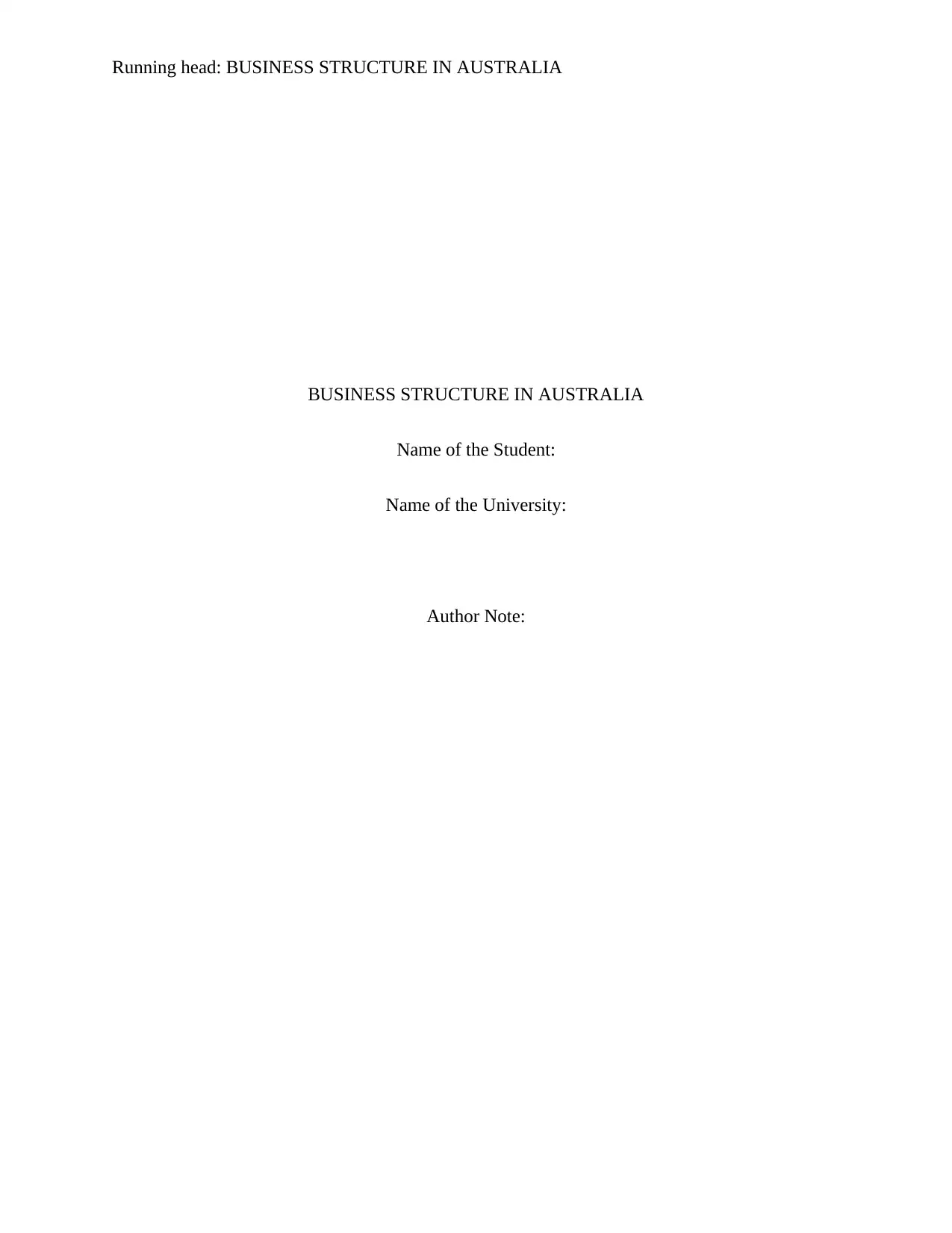
Running head: BUSINESS STRUCTURE IN AUSTRALIA
BUSINESS STRUCTURE IN AUSTRALIA
Name of the Student:
Name of the University:
Author Note:
BUSINESS STRUCTURE IN AUSTRALIA
Name of the Student:
Name of the University:
Author Note:
Paraphrase This Document
Need a fresh take? Get an instant paraphrase of this document with our AI Paraphraser
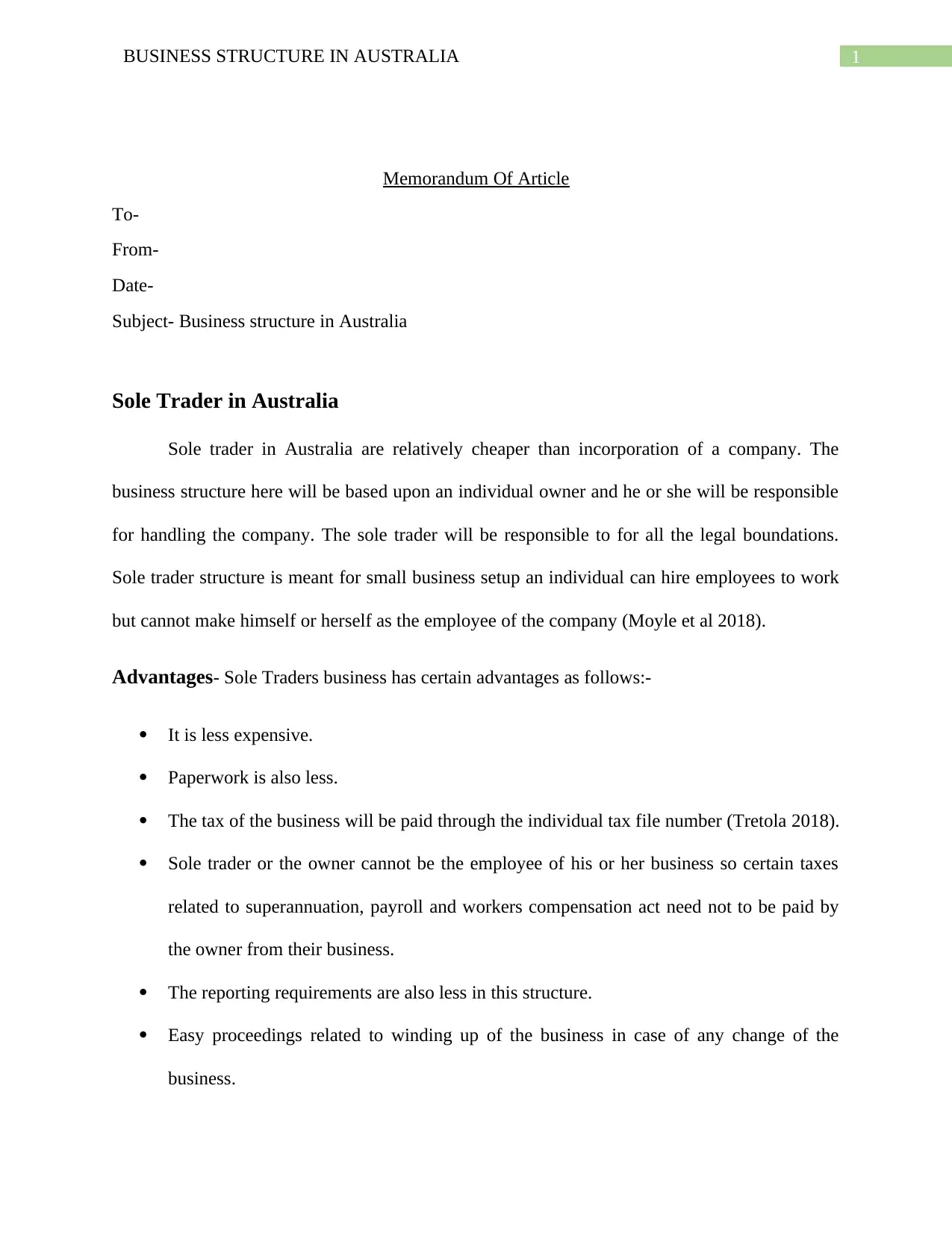
1BUSINESS STRUCTURE IN AUSTRALIA
Memorandum Of Article
To-
From-
Date-
Subject- Business structure in Australia
Sole Trader in Australia
Sole trader in Australia are relatively cheaper than incorporation of a company. The
business structure here will be based upon an individual owner and he or she will be responsible
for handling the company. The sole trader will be responsible to for all the legal boundations.
Sole trader structure is meant for small business setup an individual can hire employees to work
but cannot make himself or herself as the employee of the company (Moyle et al 2018).
Advantages- Sole Traders business has certain advantages as follows:-
It is less expensive.
Paperwork is also less.
The tax of the business will be paid through the individual tax file number (Tretola 2018).
Sole trader or the owner cannot be the employee of his or her business so certain taxes
related to superannuation, payroll and workers compensation act need not to be paid by
the owner from their business.
The reporting requirements are also less in this structure.
Easy proceedings related to winding up of the business in case of any change of the
business.
Memorandum Of Article
To-
From-
Date-
Subject- Business structure in Australia
Sole Trader in Australia
Sole trader in Australia are relatively cheaper than incorporation of a company. The
business structure here will be based upon an individual owner and he or she will be responsible
for handling the company. The sole trader will be responsible to for all the legal boundations.
Sole trader structure is meant for small business setup an individual can hire employees to work
but cannot make himself or herself as the employee of the company (Moyle et al 2018).
Advantages- Sole Traders business has certain advantages as follows:-
It is less expensive.
Paperwork is also less.
The tax of the business will be paid through the individual tax file number (Tretola 2018).
Sole trader or the owner cannot be the employee of his or her business so certain taxes
related to superannuation, payroll and workers compensation act need not to be paid by
the owner from their business.
The reporting requirements are also less in this structure.
Easy proceedings related to winding up of the business in case of any change of the
business.
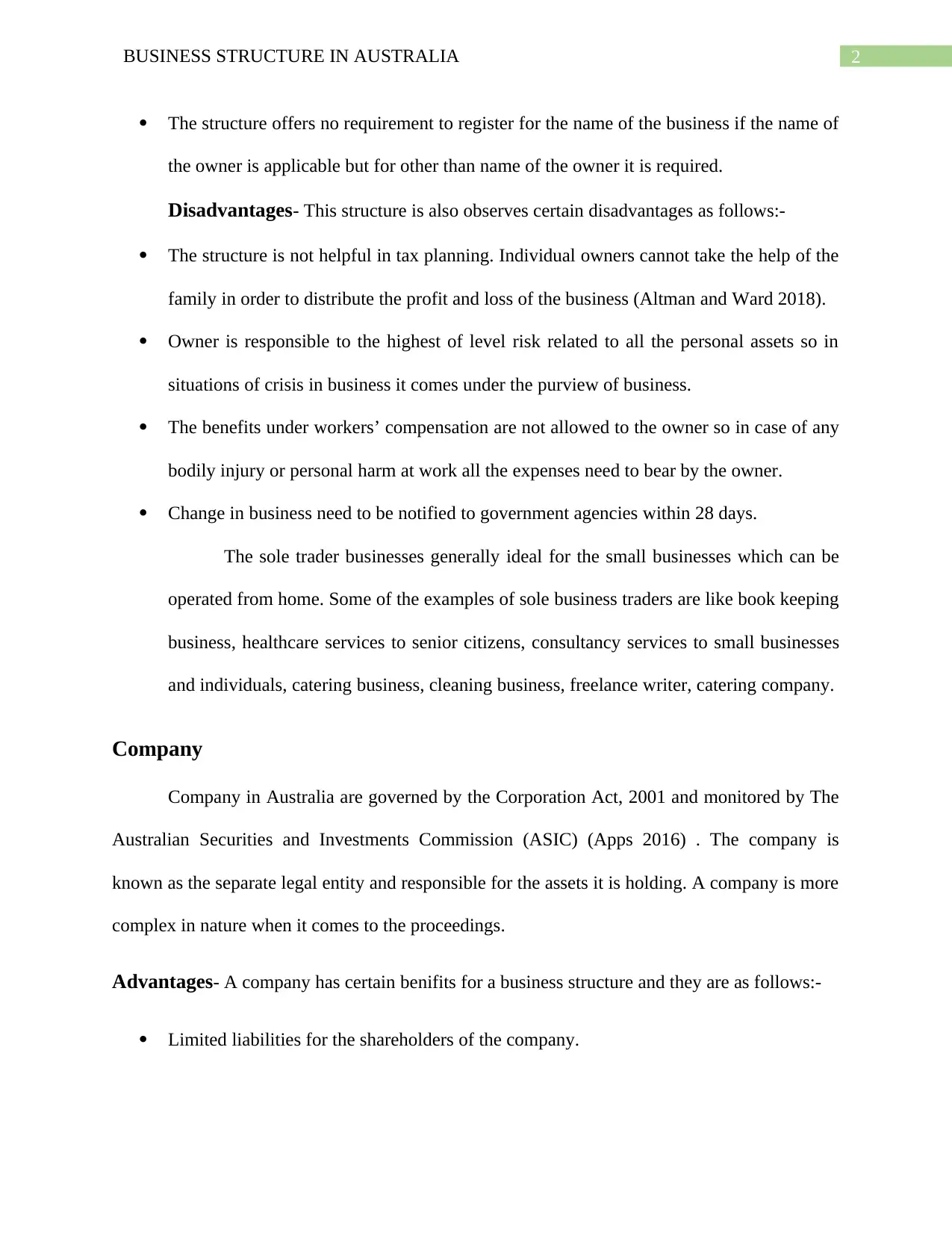
2BUSINESS STRUCTURE IN AUSTRALIA
The structure offers no requirement to register for the name of the business if the name of
the owner is applicable but for other than name of the owner it is required.
Disadvantages- This structure is also observes certain disadvantages as follows:-
The structure is not helpful in tax planning. Individual owners cannot take the help of the
family in order to distribute the profit and loss of the business (Altman and Ward 2018).
Owner is responsible to the highest of level risk related to all the personal assets so in
situations of crisis in business it comes under the purview of business.
The benefits under workers’ compensation are not allowed to the owner so in case of any
bodily injury or personal harm at work all the expenses need to bear by the owner.
Change in business need to be notified to government agencies within 28 days.
The sole trader businesses generally ideal for the small businesses which can be
operated from home. Some of the examples of sole business traders are like book keeping
business, healthcare services to senior citizens, consultancy services to small businesses
and individuals, catering business, cleaning business, freelance writer, catering company.
Company
Company in Australia are governed by the Corporation Act, 2001 and monitored by The
Australian Securities and Investments Commission (ASIC) (Apps 2016) . The company is
known as the separate legal entity and responsible for the assets it is holding. A company is more
complex in nature when it comes to the proceedings.
Advantages- A company has certain benifits for a business structure and they are as follows:-
Limited liabilities for the shareholders of the company.
The structure offers no requirement to register for the name of the business if the name of
the owner is applicable but for other than name of the owner it is required.
Disadvantages- This structure is also observes certain disadvantages as follows:-
The structure is not helpful in tax planning. Individual owners cannot take the help of the
family in order to distribute the profit and loss of the business (Altman and Ward 2018).
Owner is responsible to the highest of level risk related to all the personal assets so in
situations of crisis in business it comes under the purview of business.
The benefits under workers’ compensation are not allowed to the owner so in case of any
bodily injury or personal harm at work all the expenses need to bear by the owner.
Change in business need to be notified to government agencies within 28 days.
The sole trader businesses generally ideal for the small businesses which can be
operated from home. Some of the examples of sole business traders are like book keeping
business, healthcare services to senior citizens, consultancy services to small businesses
and individuals, catering business, cleaning business, freelance writer, catering company.
Company
Company in Australia are governed by the Corporation Act, 2001 and monitored by The
Australian Securities and Investments Commission (ASIC) (Apps 2016) . The company is
known as the separate legal entity and responsible for the assets it is holding. A company is more
complex in nature when it comes to the proceedings.
Advantages- A company has certain benifits for a business structure and they are as follows:-
Limited liabilities for the shareholders of the company.
⊘ This is a preview!⊘
Do you want full access?
Subscribe today to unlock all pages.

Trusted by 1+ million students worldwide
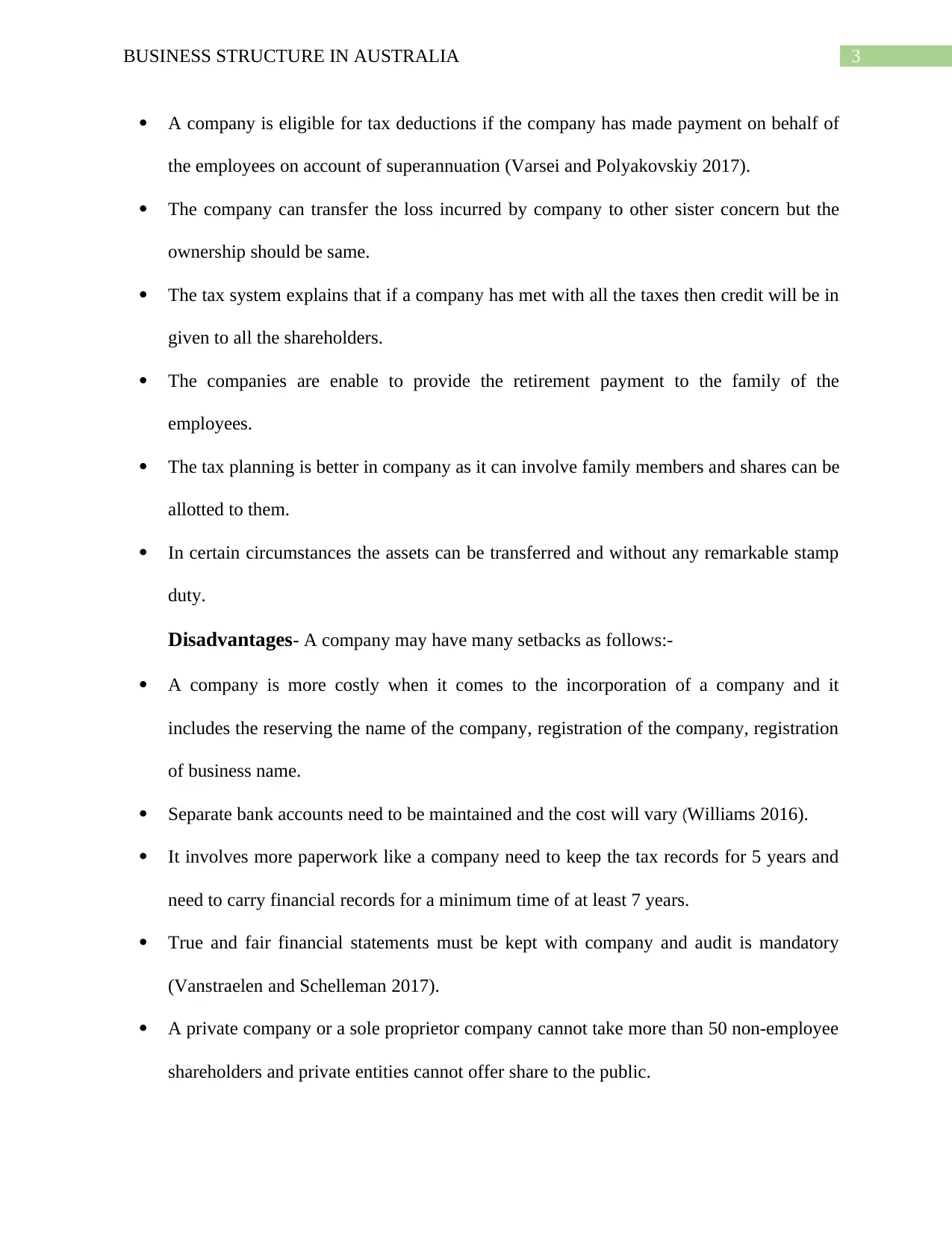
3BUSINESS STRUCTURE IN AUSTRALIA
A company is eligible for tax deductions if the company has made payment on behalf of
the employees on account of superannuation (Varsei and Polyakovskiy 2017).
The company can transfer the loss incurred by company to other sister concern but the
ownership should be same.
The tax system explains that if a company has met with all the taxes then credit will be in
given to all the shareholders.
The companies are enable to provide the retirement payment to the family of the
employees.
The tax planning is better in company as it can involve family members and shares can be
allotted to them.
In certain circumstances the assets can be transferred and without any remarkable stamp
duty.
Disadvantages- A company may have many setbacks as follows:-
A company is more costly when it comes to the incorporation of a company and it
includes the reserving the name of the company, registration of the company, registration
of business name.
Separate bank accounts need to be maintained and the cost will vary (Williams 2016).
It involves more paperwork like a company need to keep the tax records for 5 years and
need to carry financial records for a minimum time of at least 7 years.
True and fair financial statements must be kept with company and audit is mandatory
(Vanstraelen and Schelleman 2017).
A private company or a sole proprietor company cannot take more than 50 non-employee
shareholders and private entities cannot offer share to the public.
A company is eligible for tax deductions if the company has made payment on behalf of
the employees on account of superannuation (Varsei and Polyakovskiy 2017).
The company can transfer the loss incurred by company to other sister concern but the
ownership should be same.
The tax system explains that if a company has met with all the taxes then credit will be in
given to all the shareholders.
The companies are enable to provide the retirement payment to the family of the
employees.
The tax planning is better in company as it can involve family members and shares can be
allotted to them.
In certain circumstances the assets can be transferred and without any remarkable stamp
duty.
Disadvantages- A company may have many setbacks as follows:-
A company is more costly when it comes to the incorporation of a company and it
includes the reserving the name of the company, registration of the company, registration
of business name.
Separate bank accounts need to be maintained and the cost will vary (Williams 2016).
It involves more paperwork like a company need to keep the tax records for 5 years and
need to carry financial records for a minimum time of at least 7 years.
True and fair financial statements must be kept with company and audit is mandatory
(Vanstraelen and Schelleman 2017).
A private company or a sole proprietor company cannot take more than 50 non-employee
shareholders and private entities cannot offer share to the public.
Paraphrase This Document
Need a fresh take? Get an instant paraphrase of this document with our AI Paraphraser
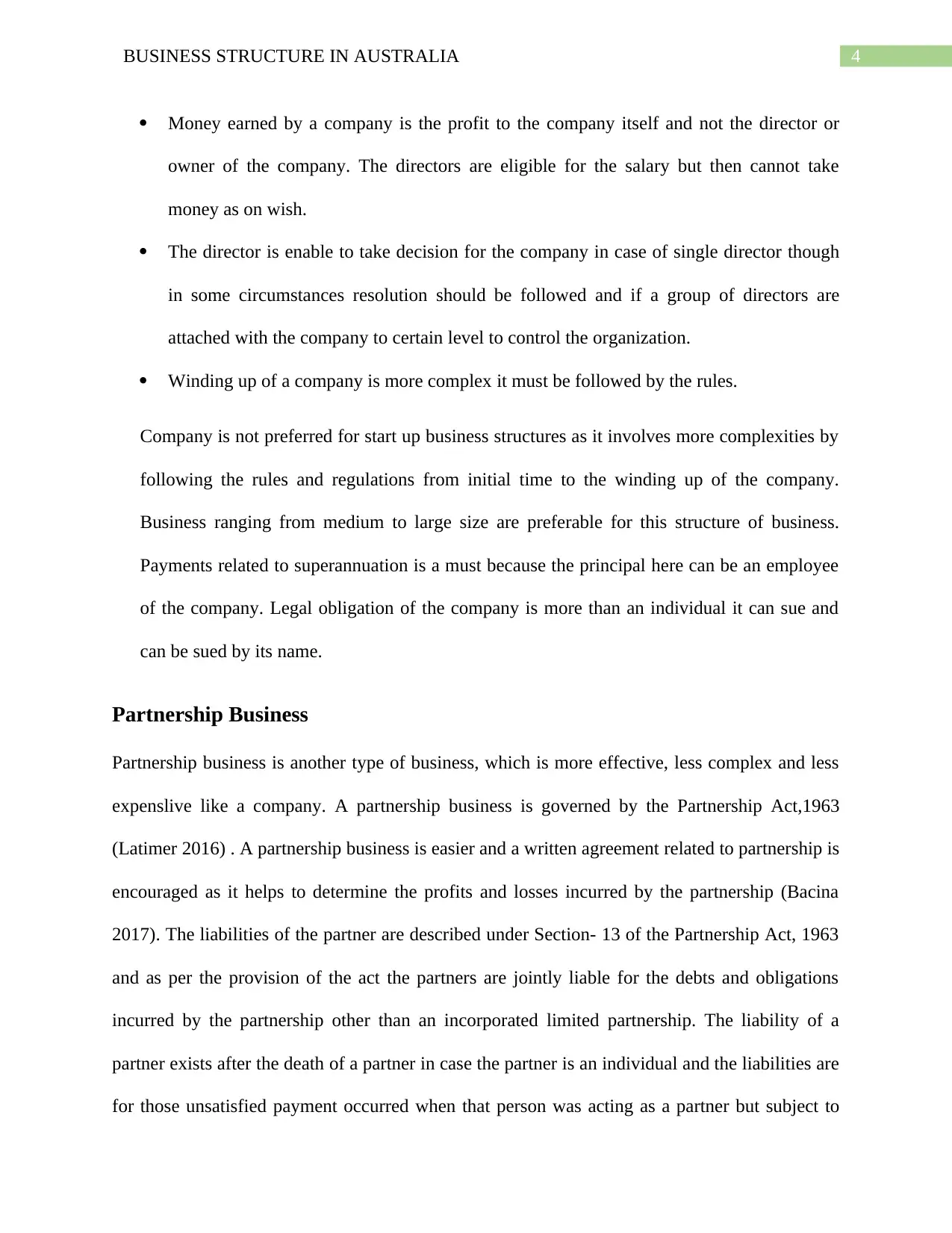
4BUSINESS STRUCTURE IN AUSTRALIA
Money earned by a company is the profit to the company itself and not the director or
owner of the company. The directors are eligible for the salary but then cannot take
money as on wish.
The director is enable to take decision for the company in case of single director though
in some circumstances resolution should be followed and if a group of directors are
attached with the company to certain level to control the organization.
Winding up of a company is more complex it must be followed by the rules.
Company is not preferred for start up business structures as it involves more complexities by
following the rules and regulations from initial time to the winding up of the company.
Business ranging from medium to large size are preferable for this structure of business.
Payments related to superannuation is a must because the principal here can be an employee
of the company. Legal obligation of the company is more than an individual it can sue and
can be sued by its name.
Partnership Business
Partnership business is another type of business, which is more effective, less complex and less
expenslive like a company. A partnership business is governed by the Partnership Act,1963
(Latimer 2016) . A partnership business is easier and a written agreement related to partnership is
encouraged as it helps to determine the profits and losses incurred by the partnership (Bacina
2017). The liabilities of the partner are described under Section- 13 of the Partnership Act, 1963
and as per the provision of the act the partners are jointly liable for the debts and obligations
incurred by the partnership other than an incorporated limited partnership. The liability of a
partner exists after the death of a partner in case the partner is an individual and the liabilities are
for those unsatisfied payment occurred when that person was acting as a partner but subject to
Money earned by a company is the profit to the company itself and not the director or
owner of the company. The directors are eligible for the salary but then cannot take
money as on wish.
The director is enable to take decision for the company in case of single director though
in some circumstances resolution should be followed and if a group of directors are
attached with the company to certain level to control the organization.
Winding up of a company is more complex it must be followed by the rules.
Company is not preferred for start up business structures as it involves more complexities by
following the rules and regulations from initial time to the winding up of the company.
Business ranging from medium to large size are preferable for this structure of business.
Payments related to superannuation is a must because the principal here can be an employee
of the company. Legal obligation of the company is more than an individual it can sue and
can be sued by its name.
Partnership Business
Partnership business is another type of business, which is more effective, less complex and less
expenslive like a company. A partnership business is governed by the Partnership Act,1963
(Latimer 2016) . A partnership business is easier and a written agreement related to partnership is
encouraged as it helps to determine the profits and losses incurred by the partnership (Bacina
2017). The liabilities of the partner are described under Section- 13 of the Partnership Act, 1963
and as per the provision of the act the partners are jointly liable for the debts and obligations
incurred by the partnership other than an incorporated limited partnership. The liability of a
partner exists after the death of a partner in case the partner is an individual and the liabilities are
for those unsatisfied payment occurred when that person was acting as a partner but subject to
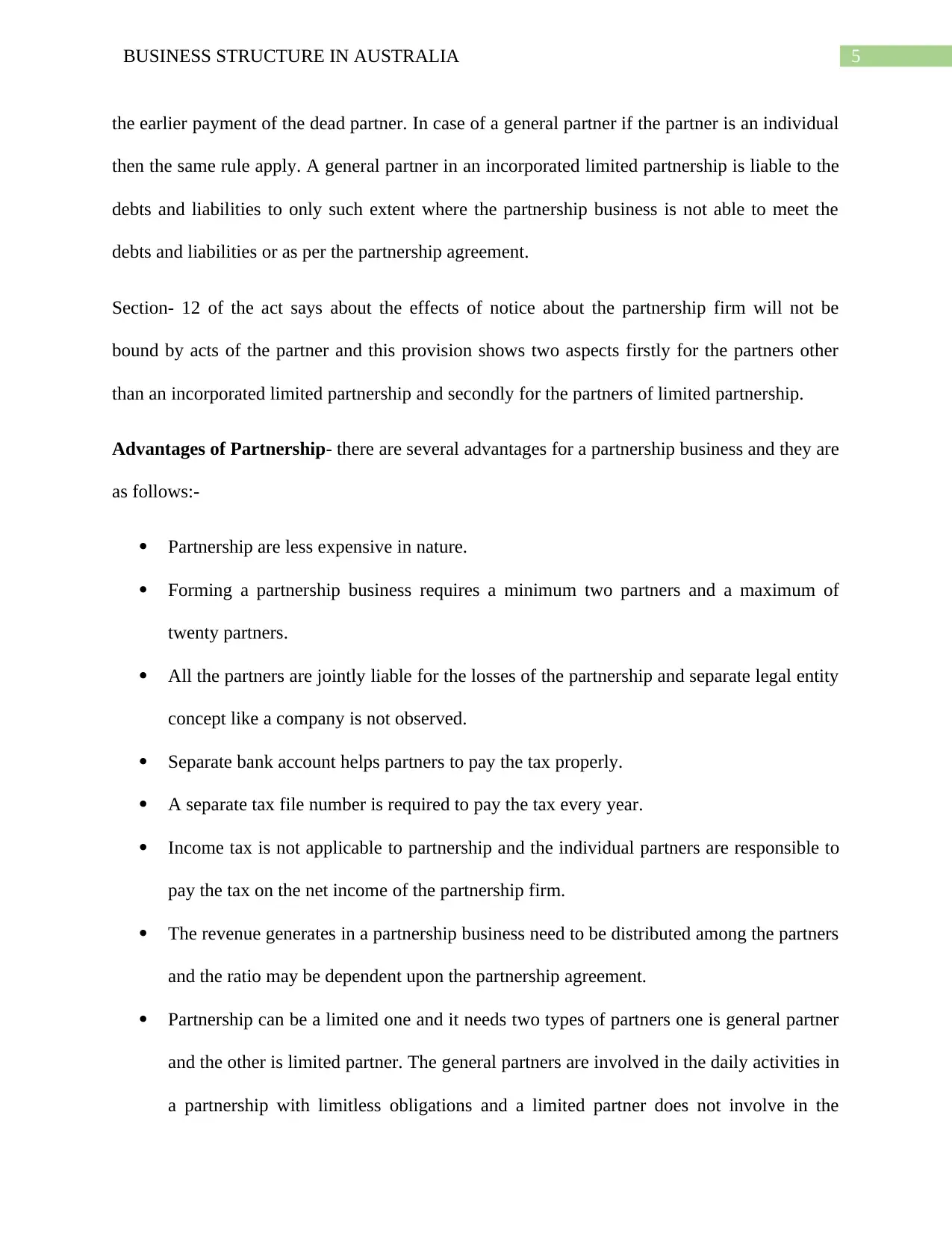
5BUSINESS STRUCTURE IN AUSTRALIA
the earlier payment of the dead partner. In case of a general partner if the partner is an individual
then the same rule apply. A general partner in an incorporated limited partnership is liable to the
debts and liabilities to only such extent where the partnership business is not able to meet the
debts and liabilities or as per the partnership agreement.
Section- 12 of the act says about the effects of notice about the partnership firm will not be
bound by acts of the partner and this provision shows two aspects firstly for the partners other
than an incorporated limited partnership and secondly for the partners of limited partnership.
Advantages of Partnership- there are several advantages for a partnership business and they are
as follows:-
Partnership are less expensive in nature.
Forming a partnership business requires a minimum two partners and a maximum of
twenty partners.
All the partners are jointly liable for the losses of the partnership and separate legal entity
concept like a company is not observed.
Separate bank account helps partners to pay the tax properly.
A separate tax file number is required to pay the tax every year.
Income tax is not applicable to partnership and the individual partners are responsible to
pay the tax on the net income of the partnership firm.
The revenue generates in a partnership business need to be distributed among the partners
and the ratio may be dependent upon the partnership agreement.
Partnership can be a limited one and it needs two types of partners one is general partner
and the other is limited partner. The general partners are involved in the daily activities in
a partnership with limitless obligations and a limited partner does not involve in the
the earlier payment of the dead partner. In case of a general partner if the partner is an individual
then the same rule apply. A general partner in an incorporated limited partnership is liable to the
debts and liabilities to only such extent where the partnership business is not able to meet the
debts and liabilities or as per the partnership agreement.
Section- 12 of the act says about the effects of notice about the partnership firm will not be
bound by acts of the partner and this provision shows two aspects firstly for the partners other
than an incorporated limited partnership and secondly for the partners of limited partnership.
Advantages of Partnership- there are several advantages for a partnership business and they are
as follows:-
Partnership are less expensive in nature.
Forming a partnership business requires a minimum two partners and a maximum of
twenty partners.
All the partners are jointly liable for the losses of the partnership and separate legal entity
concept like a company is not observed.
Separate bank account helps partners to pay the tax properly.
A separate tax file number is required to pay the tax every year.
Income tax is not applicable to partnership and the individual partners are responsible to
pay the tax on the net income of the partnership firm.
The revenue generates in a partnership business need to be distributed among the partners
and the ratio may be dependent upon the partnership agreement.
Partnership can be a limited one and it needs two types of partners one is general partner
and the other is limited partner. The general partners are involved in the daily activities in
a partnership with limitless obligations and a limited partner does not involve in the
⊘ This is a preview!⊘
Do you want full access?
Subscribe today to unlock all pages.

Trusted by 1+ million students worldwide
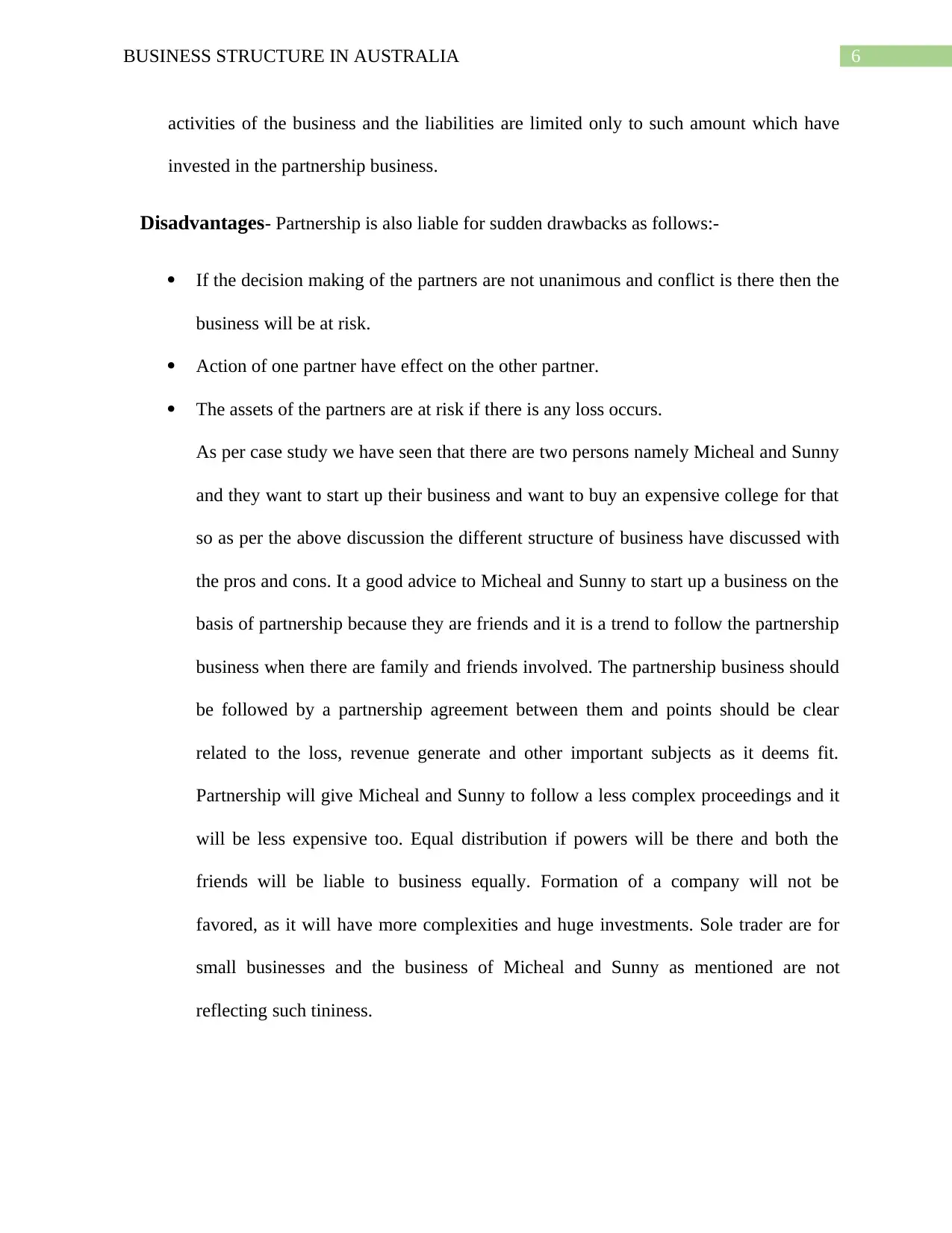
6BUSINESS STRUCTURE IN AUSTRALIA
activities of the business and the liabilities are limited only to such amount which have
invested in the partnership business.
Disadvantages- Partnership is also liable for sudden drawbacks as follows:-
If the decision making of the partners are not unanimous and conflict is there then the
business will be at risk.
Action of one partner have effect on the other partner.
The assets of the partners are at risk if there is any loss occurs.
As per case study we have seen that there are two persons namely Micheal and Sunny
and they want to start up their business and want to buy an expensive college for that
so as per the above discussion the different structure of business have discussed with
the pros and cons. It a good advice to Micheal and Sunny to start up a business on the
basis of partnership because they are friends and it is a trend to follow the partnership
business when there are family and friends involved. The partnership business should
be followed by a partnership agreement between them and points should be clear
related to the loss, revenue generate and other important subjects as it deems fit.
Partnership will give Micheal and Sunny to follow a less complex proceedings and it
will be less expensive too. Equal distribution if powers will be there and both the
friends will be liable to business equally. Formation of a company will not be
favored, as it will have more complexities and huge investments. Sole trader are for
small businesses and the business of Micheal and Sunny as mentioned are not
reflecting such tininess.
activities of the business and the liabilities are limited only to such amount which have
invested in the partnership business.
Disadvantages- Partnership is also liable for sudden drawbacks as follows:-
If the decision making of the partners are not unanimous and conflict is there then the
business will be at risk.
Action of one partner have effect on the other partner.
The assets of the partners are at risk if there is any loss occurs.
As per case study we have seen that there are two persons namely Micheal and Sunny
and they want to start up their business and want to buy an expensive college for that
so as per the above discussion the different structure of business have discussed with
the pros and cons. It a good advice to Micheal and Sunny to start up a business on the
basis of partnership because they are friends and it is a trend to follow the partnership
business when there are family and friends involved. The partnership business should
be followed by a partnership agreement between them and points should be clear
related to the loss, revenue generate and other important subjects as it deems fit.
Partnership will give Micheal and Sunny to follow a less complex proceedings and it
will be less expensive too. Equal distribution if powers will be there and both the
friends will be liable to business equally. Formation of a company will not be
favored, as it will have more complexities and huge investments. Sole trader are for
small businesses and the business of Micheal and Sunny as mentioned are not
reflecting such tininess.
Paraphrase This Document
Need a fresh take? Get an instant paraphrase of this document with our AI Paraphraser
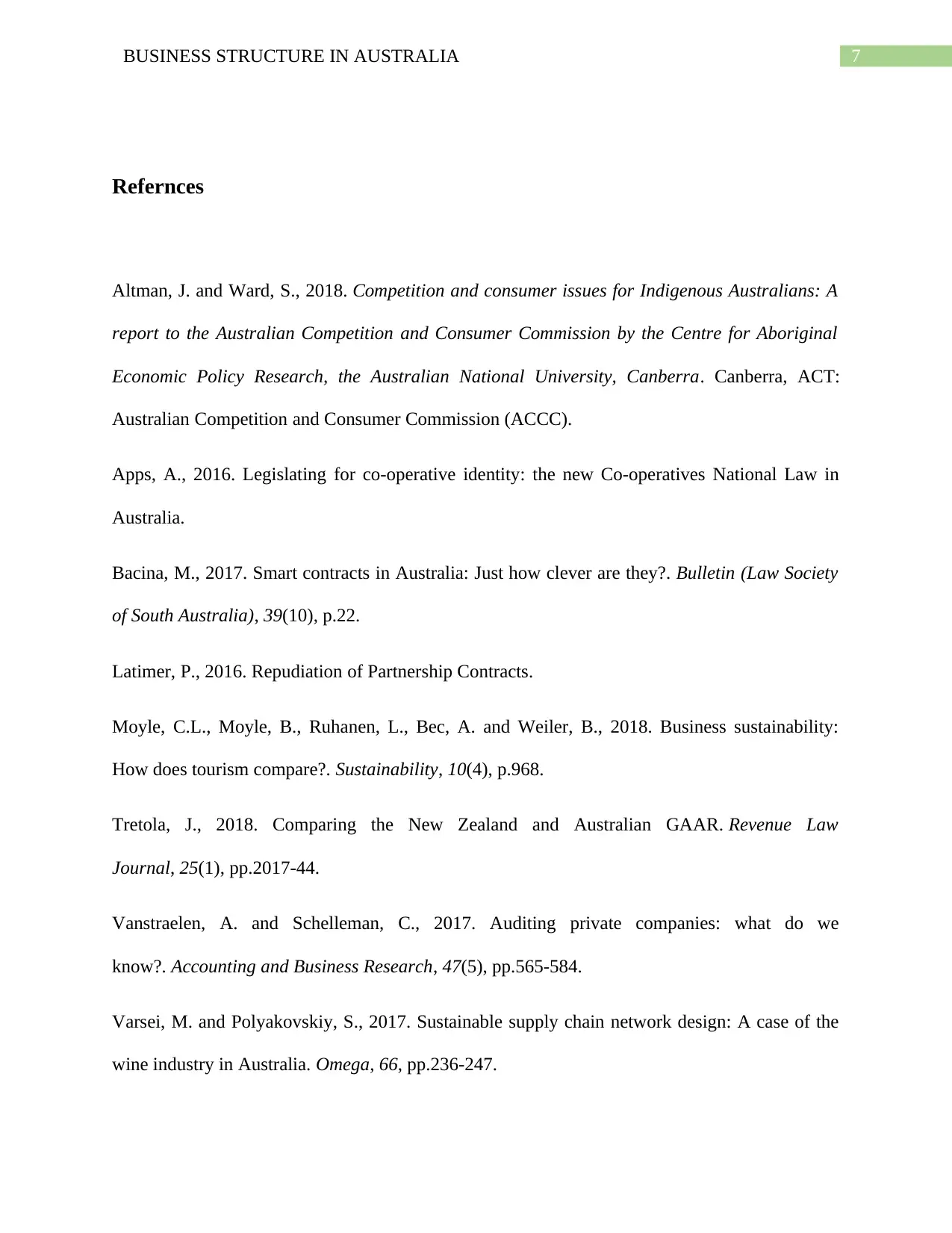
7BUSINESS STRUCTURE IN AUSTRALIA
Refernces
Altman, J. and Ward, S., 2018. Competition and consumer issues for Indigenous Australians: A
report to the Australian Competition and Consumer Commission by the Centre for Aboriginal
Economic Policy Research, the Australian National University, Canberra. Canberra, ACT:
Australian Competition and Consumer Commission (ACCC).
Apps, A., 2016. Legislating for co-operative identity: the new Co-operatives National Law in
Australia.
Bacina, M., 2017. Smart contracts in Australia: Just how clever are they?. Bulletin (Law Society
of South Australia), 39(10), p.22.
Latimer, P., 2016. Repudiation of Partnership Contracts.
Moyle, C.L., Moyle, B., Ruhanen, L., Bec, A. and Weiler, B., 2018. Business sustainability:
How does tourism compare?. Sustainability, 10(4), p.968.
Tretola, J., 2018. Comparing the New Zealand and Australian GAAR. Revenue Law
Journal, 25(1), pp.2017-44.
Vanstraelen, A. and Schelleman, C., 2017. Auditing private companies: what do we
know?. Accounting and Business Research, 47(5), pp.565-584.
Varsei, M. and Polyakovskiy, S., 2017. Sustainable supply chain network design: A case of the
wine industry in Australia. Omega, 66, pp.236-247.
Refernces
Altman, J. and Ward, S., 2018. Competition and consumer issues for Indigenous Australians: A
report to the Australian Competition and Consumer Commission by the Centre for Aboriginal
Economic Policy Research, the Australian National University, Canberra. Canberra, ACT:
Australian Competition and Consumer Commission (ACCC).
Apps, A., 2016. Legislating for co-operative identity: the new Co-operatives National Law in
Australia.
Bacina, M., 2017. Smart contracts in Australia: Just how clever are they?. Bulletin (Law Society
of South Australia), 39(10), p.22.
Latimer, P., 2016. Repudiation of Partnership Contracts.
Moyle, C.L., Moyle, B., Ruhanen, L., Bec, A. and Weiler, B., 2018. Business sustainability:
How does tourism compare?. Sustainability, 10(4), p.968.
Tretola, J., 2018. Comparing the New Zealand and Australian GAAR. Revenue Law
Journal, 25(1), pp.2017-44.
Vanstraelen, A. and Schelleman, C., 2017. Auditing private companies: what do we
know?. Accounting and Business Research, 47(5), pp.565-584.
Varsei, M. and Polyakovskiy, S., 2017. Sustainable supply chain network design: A case of the
wine industry in Australia. Omega, 66, pp.236-247.

8BUSINESS STRUCTURE IN AUSTRALIA
Williams, B., 2016. The impact of non-interest income on bank risk in Australia. Journal of
Banking & Finance, 73, pp.16-37.
Williams, B., 2016. The impact of non-interest income on bank risk in Australia. Journal of
Banking & Finance, 73, pp.16-37.
⊘ This is a preview!⊘
Do you want full access?
Subscribe today to unlock all pages.

Trusted by 1+ million students worldwide

9BUSINESS STRUCTURE IN AUSTRALIA
Paraphrase This Document
Need a fresh take? Get an instant paraphrase of this document with our AI Paraphraser

10BUSINESS STRUCTURE IN AUSTRALIA
1 out of 11
Related Documents
Your All-in-One AI-Powered Toolkit for Academic Success.
+13062052269
info@desklib.com
Available 24*7 on WhatsApp / Email
![[object Object]](/_next/static/media/star-bottom.7253800d.svg)
Unlock your academic potential
Copyright © 2020–2025 A2Z Services. All Rights Reserved. Developed and managed by ZUCOL.




